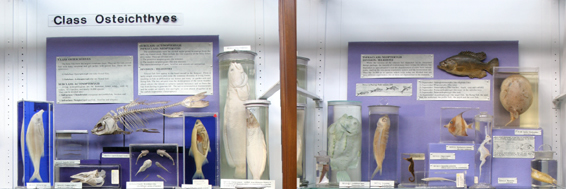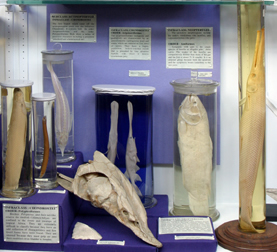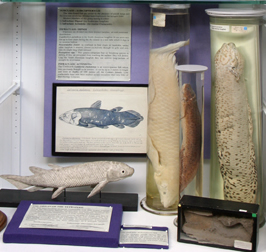
CLASS OSTEICHTHYES
 |
|||||
 |
 |
||||
The bony fish are an enormous group of very diverse types of fish which is very hard to define. Most simply, bony fish are jawed fish with bony vertebrae, gill arches and scales. They have paired fins with flexible segmented and branched rays – lepidotrichia. Bony fish have lungs which have in many types evolved into a buoyancy aid – the swim-bladder. It seems that early stages of bony fish evolution occurred in fresh water where the lung was used for respiration. The lung gradually evolved into a swim-bladder containing gases for buoyancy. In most modern fish, the gases dissolve into the swim bladder directly from the circulation. The bony fish form the largest class of vertebrates. Interestingly the 23,500+ modern species include 50 species of relict or anachronistic species that dominated the fish fauna many millions of years ago. Relict fish are generally large in size, many have heavy armour and many breathe air.
There are two major groups of bony fish as defined by the structure of their fins. The very few species of living lobe-finned fish (subclass Sarcopterygii) comprise three relict genera of lungfish and the marine coelacanth. Early sarcopterygians are believed to have given rise to the amphibians in the Devonian period (360 – 400 mya). The ray-finned fish (subclass Actinopterygii) include a small number of relict species such as sturgeons, paddle fish, gars and bowfish. The remaining 23,500+ species - the teleosts – outnumber all other groups of fish by far. Teleosts are thought to have arisen from an early actinopterygian related to the relict species alive today. The two major evolutionary lines of fish - one culminating in the vast array of modern species of bony fish, the other in the tetrapods - appeared nearly simultaneously in the fossil record.
| LOBE-FINNED FISH | RAY-FINNED FISH | MODERN TELEOSTS |






